As we usher in 2020, we somberly mourn another decade of legalized abortion which ended the lives of nearly 7.7 million preborn children. The alarming number comes from data compiled by the Guttmacher Institute — a former “special affiliate” and research arm of Planned Parenthood — which publishes more comprehensive abortion statistics than the Centers for Disease Control. The actual number is higher than 7.7 million, however, because due to a lag in published abortion data, Guttmacher’s data only represents eight years of abortions (2010 to 2017) — the latest data published. Although over 20 million abortions have taken place within the United States since 2000, abortions in the past decade have fallen dramatically.
In the past decade (between 2010 and 2017), abortions declined nearly 22 percent (21.8%):
- In 2010, Guttmacher recorded a total number of 1,102,700 abortions, averaging 3021 abortions per day.
- In 2017, Guttmacher recorded a total number of 862,320 abortions, averaging 2,363 abortions per day.
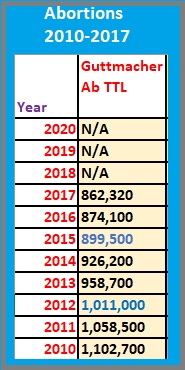
Guttmacher abortions 2000 to 2017 sheet
While abortions decrease, a Brookings Institute analysis of newly released Census Bureau estimates found that “[b]etween 2010 and 2019, the nation sustained an absolute decline of 1.14 million youth…. The nation’s population growth from 2018 to 2019 grew by a mere 0.48%… the lowest annual growth rate since 1918….”
Author William H. Frey writes, “The 2010s was a decade of fewer births, more
“Over the next decade, two factors which contributed to the slow growth of the 2010s—low fertility and an increase in deaths—will continue, as both are
Abortion by region:
- Northeast: dropped from 281,250 in 2010 to 224,310 in 2017.
- Midwest: dropped from 159,360 in 2010 to 133,120 in 2017.
- South: dropped from 374,490 in 2010 to 295,290 in 2017.
- West: dropped from 287,570 in 2010 to 209,600 in 2017.
Abortion rate/ratio:
According to Guttmacher figures, in the past decade:
- The abortion rate (abortions per 1,000 women aged 15–44) dropped from 17.7 in 2010 to 13.5 in 2017. As Live Action News previously documented, this represents its lowest level since the Roe v. Wade decision legalized abortion in all 50 states in 1973.
- The abortion ratio (abortions per 100 pregnancies ending in an abortion or a live birth) also dropped from 21.7 in 2010 to 18.4 in 2017.
- Between 2010 and 2017 (latest data available) reported abortions decreased nearly 22 percent (21.8%).
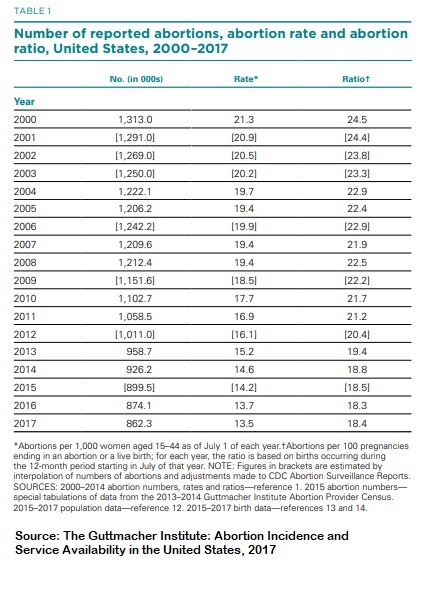
Guttmacher abortions 2000 to 2017
Abortion providers:
According to Guttmacher, “the number of providers peaked in 1981 at approximately 2,900 facilities and declined steadily to about 1,800 facilities in 2000.” In the past decade, the numbers continued to decline.
- In 2008, Guttmacher reported 1,793 abortion providers and 851 abortion facilities.
- By 2011, the number fell to 1,720 abortion providers and 839 abortion facilities.
- By 2017, the number decreased further to 1,587 abortion providers and 808 abortion facilities.
- In 2012, Guttmacher noted that “only 34% of all facilities that provided abortion in the United States offered the procedure at 20 weeks’ gestation; 16% did so at 24 weeks.”
- According to Guttmacher’s latest report, “Seventy-two percent of clinics offered abortions up to 12 weeks’ gestation in 2014, 25% up to 20 weeks and 10% up to 24 weeks.”
Abortions by Race/Ethnicity:
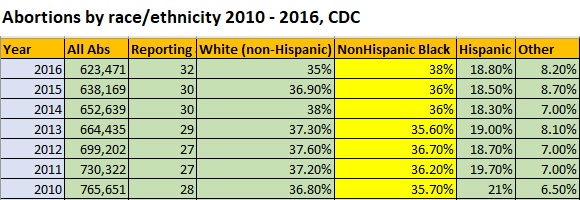
CDC abortion 2010 to 2016 by race
The Centers for Disease Control (CDC) reported a total of 765,651 abortions in 2010 and 623,471 abortions in 2016. While abortions overall were in decline, CDC data between 2010 (28 reporting areas) and 2016 – the latest data available (32 reporting areas) – reveals that Black women still account for the largest percentage of abortions, and those percentages are on the increase.
- White: 36.8% in 2010 dropping to 35% in 2016.
- Black: 35.7% in 2010 increasing to 38% in 2016.
- Hispanic: 21% in 2010 dropping to 18.8% in 2016.
We estimate that between 2010 and 2016 over 1.7 million Black babies lost their lives from abortion.
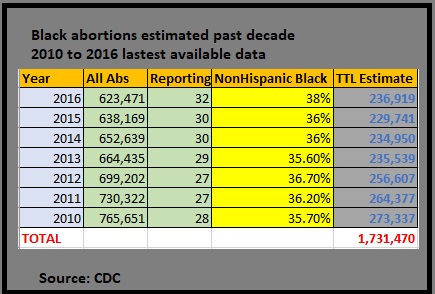
Black abortions past decade 2010 to 2016 CDC
Abortion by pill:
- According to Planned Parenthood, between 2000 and 2010, nearly 1.4 million U.S. women had used Mifeprex – the abortion pill – to end their pregnancies. PP claims to have provided 550,700 of those pills to women.
- In 2011, use of the abortion pill (dubbed “medication abortion”) accounted for 23% of all nonhospital abortions.
- By 2017, chemical abortion accounted for nearly 40 percent (39%) of all reported abortions (339,640 medication abortions out of 862,320 total reported).
- By the end of 2018, 3.7 million women used mifepristone in the U.S. for the medical termination of pregnancy. The FDA has identified approximately 4,200 instances of adverse events associated with Mifeprex and at least 24 deaths. (Editor’s Note, 4/18/21: The FDA has received reports of serious adverse events in women who took Mifeprex. As of December 31, 2018, there were reports of 24 deaths of women associated with Mifeprex since the product was approved in September 2000, including two cases of ectopic pregnancy resulting in death; and several cases of severe systemic infection (also called sepsis), including some that were fatal. The adverse events cannot with certainty be causally attributed to mifepristone because of concurrent use of other drugs, other medical or surgical treatments, co-existing medical conditions, and information gaps about patient health status and clinical management of the patient. A summary report of adverse events that reflects data through December 31, 2018 is here.)
Self-Abortion:
A study published in 2011 claimed that only a small percentage of women had reported attempting a self-abortion. “Only 1.2% of women obtaining abortions report having ever used misoprostol on their own to ‘bring back’ their period or end a pregnancy. A similarly small proportion of women, 1.4%, reported using other substances, such as vitamin C or herbs, to attempt to end a pregnancy.”
But today, due to heavy promotion by abortion insiders, dangerous unreported self-managed abortions — which occur outside of FDA safety protocols — may be increasing, though there is no way to know for sure. In 2017, Guttmacher appeared to be pointing to an alleged increase in “self-managed” or “illegal” abortions to account for the decline in the total number of abortions for 2017. Yet further down in the document, Guttmacher states, “it is nonetheless unlikely that even a substantial increase in self-managed abortion can account for the majority of the decline in abortion incidence nationally during the study period.”
Live Action News has previously documented the sale of illegal abortion pills by groups like Aid Access, who are defying the FDA’s warnings to “immediately cease” dispensation of the drugs. The group reportedly filled 2,500 prescriptions in 2018, according to a letter from Aid Access to the FDA. However, a lawsuit later filed by the group noted it had actually shipped 7,131 abortion pills to women in the U.S. between March 30, 2018, and August 27, 2019. To date, as Live Action News documented here, while the FDA has a history of shutting down websites of other drugs or products sold illegally, the agency has failed to do so with illegally sold abortion pills.
Abortions have declined over the past decade
The decline in abortions over the past decade can be credited to a number of factors, including the passage of reasonable abortion restrictions, pro-life prayer and sidewalk counseling reaching out to women at abortion facilities, and the powerful impact of pregnancy resource centers.
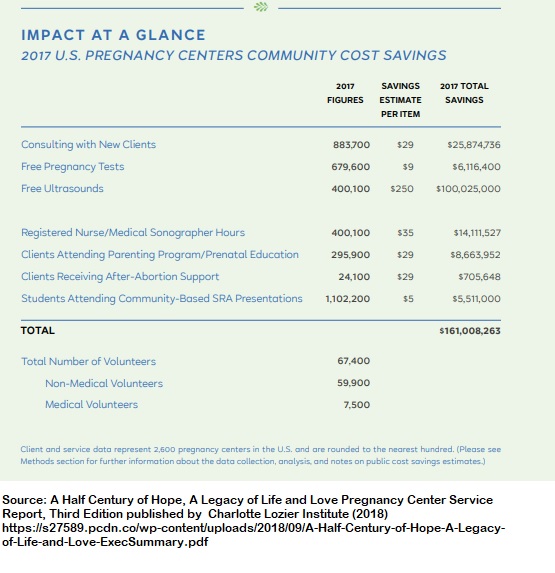
Lozier 2018 report pro-life Pregnancy Resource Centers
According to an analysis published by the Charlotte Lozier Institute, in 2017, an estimated 2,600 pro-life pregnancy centers provided nearly 2,000,000 people in the United States with free services, with an estimated community cost savings of at least $161 million annually. The report notes, “While some pregnancy centers receive public monies through various federal and state programs and funding streams, at least 90 percent of total funding for pregnancy centers is raised locally at the community level. In 2017, a total of 86 percent of centers received no public funding; 14 percent, or 364 pregnancy center organizations, received federal or state funding at some level.”
Today, thanks to an estimated 67,400 pro-life pregnancy center volunteers (of which 7,500 are estimated to be medical professionals) and a myriad of pro-life groups and sidewalk counselors, babies are being saved from the violence of abortion and parents are receiving life-affirming help and hope.
“Like” Live Action News on Facebook for more pro-life news and commentary!







